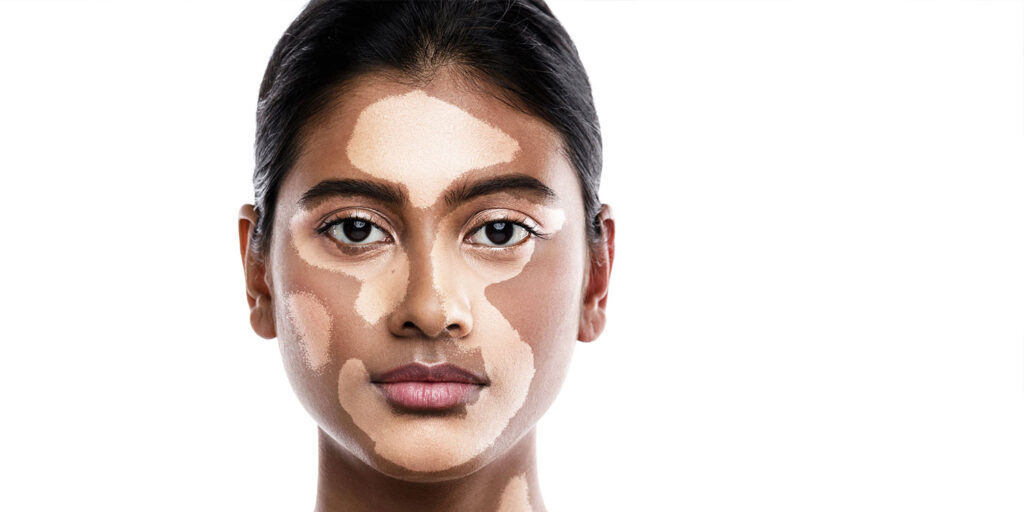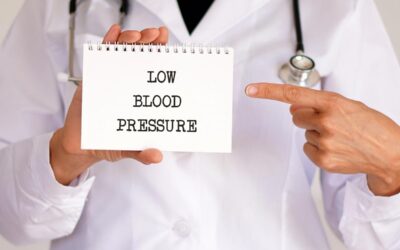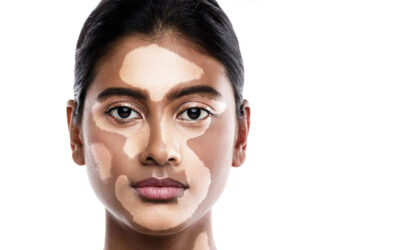Living with Vitiligo: Causes, Treatment Options, and Routine Care

Vitiligo is a skin condition where some parts of the skin lose their colour and turn white. This happens when the cells that produce skin pigment (called melanin) stop working or are destroyed. Although vitiligo is not harmful or contagious, its visible appearance can affect a person’s confidence and emotional well-being. In India, many people still have doubts and fears about this condition due to limited awareness. This article aims to explain vitiligo clearly by covering what causes it, how it can be managed, what treatments are available (including home remedies), and when to seek medical advice. The goal is to help those living with vitiligo better understand the condition and take informed steps towards care and support.
Table of Contents
ToggleUnderstanding Vitiligo Skin Disease
Vitiligo is a long-term condition that causes patches of skin to lose their natural colour. It occurs when melanocytes, the cells responsible for producing melanin, stop functioning or are destroyed. Melanin is what gives skin, hair, and eyes their colour. When these cells are absent or inactive, white or pale patches begin to appear on the skin.
Vitiligo can affect any part of the body, including the face, hands, arms, legs, and even areas such as the lips or genitals. In some cases, it also affects the scalp, leading to early greying of hair. While the condition may remain stable for years, it can also spread unpredictably over time.
There are different types of vitiligo, such as:
- Non-segmental vitiligo: The most common form, usually appearing on both sides of the body in a symmetrical pattern.
- Segmental vitiligo: Often starts at an early age and affects only one part or side of the body.
- Focal vitiligo: Limited to one or a few areas, without spreading for years.
- Lip and mucosal vitiligo: Involves the lips and inner parts of the mouth or nose.
Although the exact pattern and extent of pigment loss vary from person to person, understanding its nature is the first step towards proper care and support.
Vitiligo Causes and Risk Factors
The exact cause of vitiligo is not fully understood, but it is believed to be linked to a combination of genetic, autoimmune, and environmental factors. In vitiligo, the body’s immune system may mistakenly attack and destroy the melanocytes, leading to a loss of skin pigment. Several possible factors may increase the chances of developing vitiligo:
- Autoimmune conditions: People with autoimmune diseases such as thyroid disorders, type 1 diabetes, or rheumatoid arthritis are more likely to develop vitiligo.
- Genetics: A family history of vitiligo or other autoimmune diseases can increase risk. However, not everyone with a genetic link develops the condition.
- Oxidative stress: Imbalance in the body’s natural ability to handle harmful molecules (free radicals) may contribute to the destruction of melanocytes.
- Skin trauma: Cuts, sunburns, or exposure to certain chemicals may trigger vitiligo in some individuals.
- Emotional stress: While not a direct cause, prolonged stress may worsen existing vitiligo or contribute to its onset in those who are already at risk.
Vitiligo is not caused by poor hygiene, diet, or infection. It cannot be spread through physical contact, and it affects people of all skin tones, although the contrast is more noticeable on darker skin.
Signs and Symptoms of Vitiligo
Vitiligo usually begins with small, pale spots on the skin that gradually become lighter and eventually turn white. These patches are often irregular in shape and can vary in size. Over time, they may remain stable or spread to other parts of the body. Some of the most common signs include:
- White or depigmented patches on the skin, especially on areas exposed to the sun such as the face, hands, arms, and feet.
- Vitiligo on the lips, fingertips, or around the mouth and eyes.
- Early greying of hair on the scalp, eyebrows, eyelashes, or beard.
- Loss of colour in the mucous membranes, such as the inside of the mouth or nose.
These patches are usually painless and do not cause itching, but their appearance can be distressing. The extent and speed of pigment loss vary from person to person. In some cases, the condition may stop progressing on its own, while in others, it may continue to spread slowly or rapidly.
Vitiligo Management: Medical and Lifestyle Approaches
Living with vitiligo involves more than just treating the skin. A combination of medical care, skin protection, and emotional support can help individuals manage the condition effectively and maintain a good quality of life.
Medical management often focuses on controlling pigment loss and slowing down the progression. While there is no permanent cure, timely intervention can help reduce the appearance of patches and restore skin colour in some cases. At the same time, daily care and lifestyle adjustments play a vital role, such as:
- Sun protection: Skin with vitiligo is more sensitive to sunlight. Using sunscreen, wearing protective clothing, and avoiding excessive sun exposure can prevent burns and reduce contrast between normal and depigmented skin.
- Gentle skincare: Avoiding harsh soaps, chemical products, and skin trauma can help minimise irritation and flare-ups.
- Cosmetic camouflage: Makeup or skin-matching creams can help cover patches and improve appearance, especially in visible areas.
- Psychological support: Vitiligo can affect self-esteem. Speaking to a counsellor or joining support groups can be helpful in coping with emotional challenges.
Incorporating these measures along with medical treatment can make a significant difference in how individuals live with and respond to the condition.
What Is the Best Treatment for Vitiligo?
The choice of treatment for vitiligo depends on the extent of pigment loss, the areas affected, and how the condition is progressing. While vitiligo cannot always be reversed completely, many treatment options are available to help restore colour to the skin and manage the condition more effectively.
Common treatments include:
- Topical Medications: Corticosteroid creams or calcineurin inhibitors may help reduce inflammation and stimulate repigmentation, especially in early stages or small patches.
- Phototherapy (Light Therapy): Narrowband UVB (NB-UVB) therapy is one of the most effective treatments. It involves exposing the skin to controlled ultraviolet light under medical supervision to encourage melanin production.
- Excimer Laser: Used for targeted areas, especially in localised vitiligo. It delivers a focused beam of UVB light to help improve pigmentation.
- Surgical Treatments: For stable vitiligo that hasn’t changed for over a year, procedures such as skin grafting or melanocyte transplants may be considered. These are typically recommended when other treatments have not been effective.
- Lip Vitiligo Treatment: Vitiligo on the lips is particularly challenging due to the delicate nature of the area. Treatments often include topical medications and laser therapy, though results may take time and vary from person to person.
While some people respond well to treatment, others may see only limited improvement. Regular follow-up with a dermatologist is important to assess progress and adjust the treatment plan as needed.
Natural Remedies for Vitiligo: What Works and What Doesn’t
Many individuals explore natural remedies in hopes of managing vitiligo without medication. While some traditional remedies have shown potential benefits, most lack strong scientific evidence. It is important to approach these options with realistic expectations and under medical guidance.
Popular natural remedies include:
- Turmeric and mustard oil paste: This home remedy is often applied to white patches for its anti-inflammatory properties, though clinical results are limited.
- Psoralea seeds (Babchi): Used in Ayurveda, these seeds are believed to promote melanin production. However, they can cause skin sensitivity and must be used cautiously.
- Gingko biloba: Some studies suggest this herb may help slow the spread of vitiligo due to its antioxidant effects.
- Coconut oil: Helps in moisturising dry skin and reducing irritation, though it does not directly restore pigment.
- Dietary changes: A diet rich in antioxidants, iron, and vitamin B12 may support skin health. Foods such as leafy greens, lentils, almonds, and turmeric milk are commonly included.
While these remedies are widely used in Indian households, they should not replace medical treatment. In some cases, using unverified methods may worsen the condition or delay proper care. A balanced approach combining lifestyle changes with dermatologist-guided treatment is often most effective.
When to Consult a Doctor
Although vitiligo is not a painful or life-threatening condition, timely medical attention is important, especially when the patches are spreading or affecting sensitive areas. Early diagnosis can help slow down progression and improve treatment outcomes.
Consider seeing a doctor if:
- The white patches are increasing in size or number over a short period.
- Vitiligo appears on visible areas such as the face, lips, or hands, causing emotional stress or discomfort.
- There is loss of colour in the eyes, hair, or mucous membranes.
- Daily activities or self-confidence are being affected.
- A child or adolescent shows early signs of pigment loss.
Delaying consultation may limit treatment options, especially for progressive cases. A dermatologist can help confirm the diagnosis, rule out other skin pigment disorders, and guide the right treatment approach for long-term management.
Final Thoughts
Vitiligo may change how the skin looks, but it does not define a person’s health or worth. With the right medical support, skincare, and emotional guidance, it is possible to live confidently while managing the condition. Whether choosing medical treatments, exploring natural remedies, or focusing on daily care, what matters most is making informed decisions based on expert advice. For those noticing changes in skin colour or concerned about vitiligo, consulting a dermatologist can provide clarity and direction. Early support can go a long way in ensuring effective care and peace of mind.
To consult a specialist for vitiligo diagnosis or treatment, book an appointment at Graphic Era Hospital today.
Frequently Asked Questions
Can vitiligo be cured permanently?
There is no permanent cure for vitiligo, but various treatments can help restore skin colour and slow the spread of patches. Early treatment often gives better results.
Is lip vitiligo more difficult to treat?
Yes, vitiligo on the lips can be more challenging due to the delicate nature of the area. Treatments may take longer and require specialised approaches such as laser therapy or topical medication.
Is vitiligo the same as leukoderma?
The terms vitiligo and leukoderma are often used interchangeably, especially in India. However, leukoderma can also refer to pigment loss caused by injuries, burns, or skin damage, while vitiligo is an autoimmune condition with no external cause.
Are there dietary restrictions for people with vitiligo?
There are no strict restrictions, but a balanced diet rich in antioxidants, vitamins, and minerals may support skin health. Some people also prefer avoiding processed foods and excessive dairy, though scientific evidence is limited.
What are the side effects of vitiligo treatment?
Some treatments, such as topical steroids or light therapy, may cause thinning of the skin, irritation, or sensitivity. A dermatologist can help manage these risks and suggest the safest options.
Does vitiligo spread through touch or sharing personal items?
No, vitiligo is not contagious. It cannot spread through skin contact, sharing utensils, or close physical interaction.
By Specialities
- Bariatric Surgery
- Cancer Care
- Cardiology
- Dental
- Dermatology
- Diabetes & Endocrinology
- Endocrinology and Diabetes
- ENT (Ear Nose Throat)
- Eye Care
- Gastroenterology
- Haematology
- Health Care
- Health Tips
- Hematology
- Hepatology
- Internal Medicine
- Mental Health and Behavioural Sciences
- Metabolic
- Neonatology
- Nephrology
- Neurology
- Nutrition & Dietetics
- Obstetrics & Gynaecology
- Oncology
- Ophthalmology
- Orthopaedics
- Paediatric
- Physiotherapy & Rehabilitation
- Plastic and Reconstructive Surgery
- Psychology
- Pulmonology
- Rheumatology
- Spine
- Urology
Recent Posts
- What Causes a Sudden Drop in Blood Pressure? Know the Symptoms Before It’s Too Late
- Burning Sensation While Urinating: Common Causes and When to See a Urologist
- Strep Throat (Bacterial Infection): Symptoms, Diagnosis, and Effective Care
- International Day of Persons with Disabilities 2025: Breaking Barriers, Building a More Inclusive Future
- World AIDS Day 2025: Transforming HIV Care Through Awareness and Action
Need expert medical advice?
Share your details and our healthcare specialists will reach out to assist you.
By proceeding, you acknowledge and agree to our Privacy Policy, Terms of Use, and Disclaimer.



















